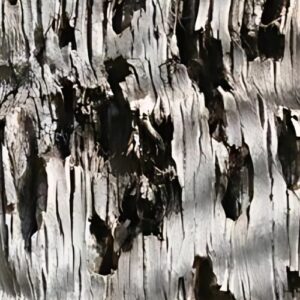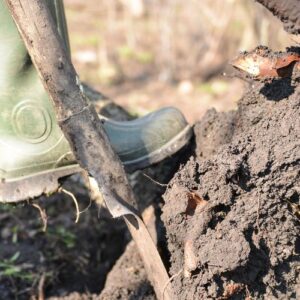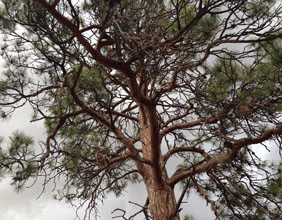
If there has been an active monsoon season (like there has been at the time of this article being written), you might have noticed that your tecoma plants may not look as healthy as they normally do.
This is thanks to a caterpillar that will eventually become a moth, one that is very active in the Phoenix and Anthem areas after a significant amount of rainfall.
In this article, we’ll cover:
- How to recognize if you have a tecoma plant,
- What symptoms to look for,
- Information on what is causing the damage,
- Some treatment options,
- And more!
Do you have a Tecoma plant?
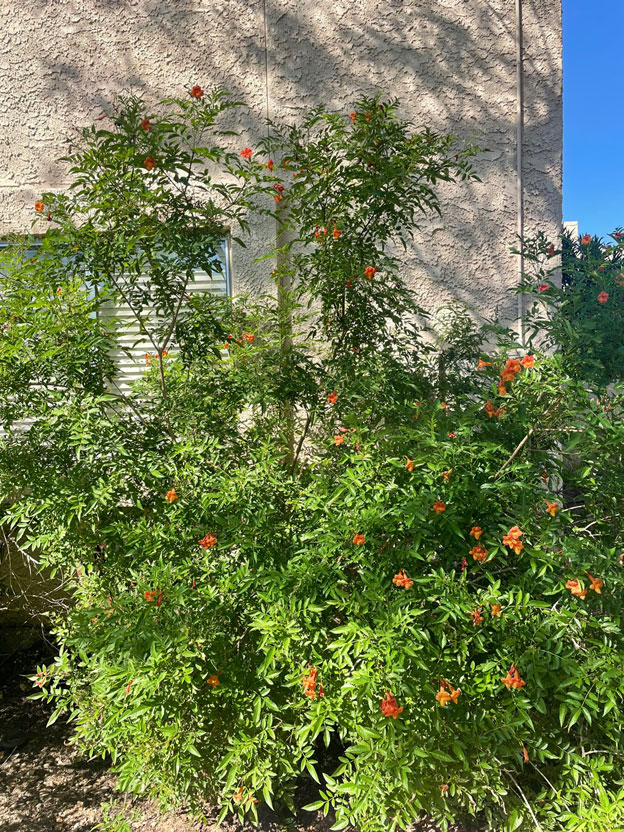
There are four varieties of tecomas found in the Phoenix and Anthem areas, commonly known as “yellow bells” for the plants that produce yellow, bell-shaped flowers, and “orange jubilee” for the ones that have orange flowers.
- Tecoma stans
- Tecoma stans var. angustata – Arizona yellow bells, narrow leaf (sometimes called the narrow-leaf trumpet bush)
- Tecoma aleta – orange bells or orange-flowered tecoma
- Tecoma garrocha – Argentine tecoma
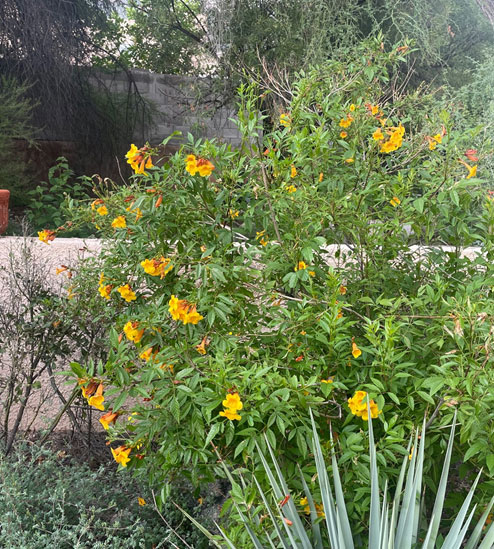
There are also hybrids available, including
‘Bells of Fire’ – red flowers, smaller shrub
‘Crimson Flare’ – deep red flowers
‘Sierra Apricot’ – dwarf hybrid with apricot-colored flowers
‘Solar Flare’ – tangerine-colored flowers
‘Sparky’ – maroon and yellow flowers
‘Sunrise’ – copper and yellow flowers
You can learn more about tecomas in our article on spring-flowering shrubs.
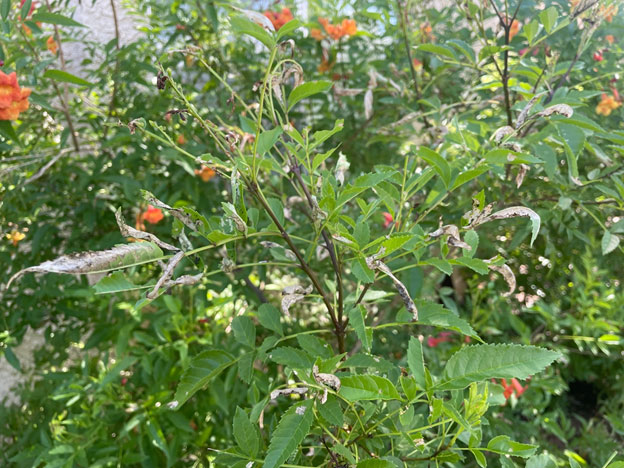
Tecoma Plant Damage
After (or during) a wet monsoon season, caterpillars can become active on tecoma plants. While you may not spot the caterpillars themselves, the damage will be clear to spot. Look for:
- Leaves rolled up
- Leaves turning tan and thin, almost transparent, “skeletonized”
- Leaves folded over and sealed with dense webbing
- Small black droppings (called “frass”)
What Causes This Damage?
The tecoma leaf tier moth (Antigastra catalaunalis) is the caterpillar that is affecting the tecoma plants. It feeds mostly on yellow and orange bells. You can see images of the tecoma leaf tier in this blog post.
They are called “leaf tiers” because of the way that they wrap themselves in the leaves to form a sort of cocoon. They then tie themselves into the cocoon with their webbing, so the word “tiers” refers to them tying the leaves together.
While the black dots on the leaves may at first to be tiny insects, they are actually the droppings from the caterpillars, called frass.
The caterpillars eventually become moths, important pollinators in our area. The caterpillars and the moths are an important food source for frogs, lizards, bats, birds, and other wildlife.
Treatment Options for Tecoma Damage
There are several levels of treatment that you can consider if you notice damage to your tecoma plants. We’ll cover four of them here.
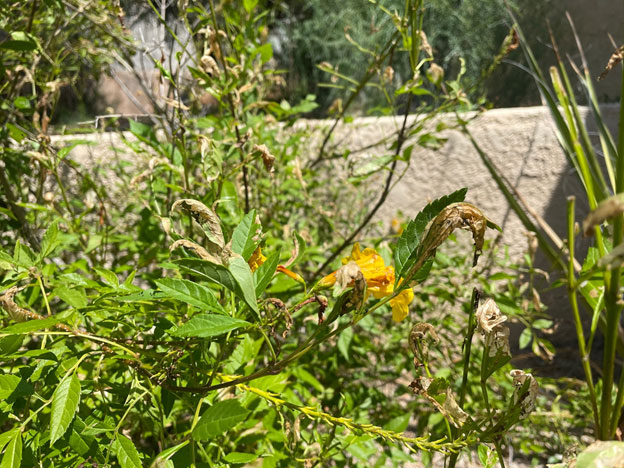
1. Leave the plants alone
Two good things about this option are that you are letting nature run its course and that you don’t have to do anything at the moment. As strange as it may seem, many experts advise doing nothing. Thanks to the added rains from the monsoon season, your tecomas are probably much larger than they were at the beginning of the summer. This means that, in some ways, the caterpillar damage is almost a form of natural pruning.
In other words, losing some leaves to the caterpillar damage shouldn’t do any harm to your plant. Just prune off the dead sections and dispose of the damaged areas (in your trash, not in compost. You don’t want the caterpillars to spread). Tecomas recover quickly after pruning, and can sometimes flower even more! They can even handle rejuvenation pruning if the damage is severe.
If you choose this option, be sure that your plant is receiving enough water, and you might want to consider feeding it with some organic compost or fertilizer.
2. Prune the plants now
A second option is to prune off the affected sections now, potentially removing the caterpillars along with the dead leaves. This may stop the caterpillars from causing any additional damage….but then again, it might not.
3. Spray with soapy water
If you’d like to do more to stop the caterpillar damage but don’t want to use any kind of pesticide, you can spray your plants with soapy water. Ordinary dish soap seems to do the trick, or you can use this recipe (that includes chilis) to control caterpillars.
4. Use Bt to kill the caterpillars
If you are bound and determined to stop the caterpillars before they do any more cosmetic damage, you can use Bt, Bacillus thuringiensis, a pesticide approved by the EPA. Bt infects the larval insects from the inside out, so that they get sick and die once they ingest it. It should not harm any other animals in your yard, but it is a pesticide so use it carefully and in moderation. Certain kinds need to be diluted with plenty of water before use.
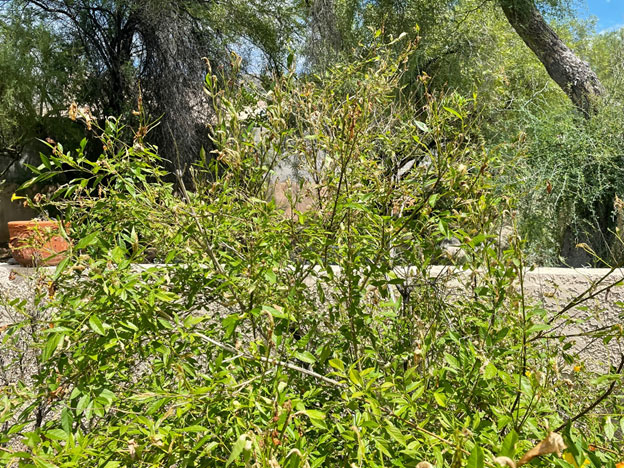
Our suggestion at Titan Tree Care is to wait and see – tecomas can take a lot of damage before the tecoma leaf tiers actually harm the plant, and these caterpillars are just a natural part of the environment. They are not invasive but instead are an important moth in our natural ecosystem. Your plants may not look as beautiful with the damage, but they should recover and come back with even more blooms after their next pruning.
If you have any questions about your tecomas or about other areas of your trees or landscape, don’t hesitate to contact Titan Tree Care to schedule a consultation.
More Articles Like This

Titan Tree Care is a full-service tree care company located in Anthem, AZ and serving all of North Phoenix. We offer a wide range of services to meet your tree care needs, including tree and palm trimming, tree pruning, tree removal, stump grinding, and more. We also offer insect or disease treatments and fertilization services. We are dedicated to providing high-quality, safe, and effective tree care services to our customers and work hard to ensure that your trees are healthy and look their best.





